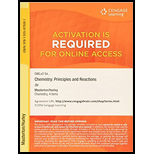
Consider the reaction
(a) Calculate ?H° for this reaction. Is it exothermic or endothermic?
(b) Would you expect ?S° to be positive or negative? Calculate ?S°.
(c) Is the reaction spontaneous at 25°C and 1 atm?
(d) At what temperature, if any, is the reaction at equilibrium at 1 atm pressure?
(a)
Interpretation:
To calculate
Concept introduction:
A reaction is endothermic if it gains energy from surroundings that is,
Answer to Problem 53QAP
Explanation of Solution
From appendix (1),
Hence, value of
Since,
(b)
Interpretation:
To calculate
Concept introduction:
Standard entropy is calculated from difference of entropy of product and reactant.
Where,
Answer to Problem 53QAP
Explanation of Solution
From appendix (1),
Hence,
(c)
Interpretation:
To find the below reaction is spontaneous or not at
Concept introduction:
A reaction is called spontaneous if the value of Standard Gibbs Free energy is less than zero.
Answer to Problem 53QAP
Reaction is spontaneous.
Explanation of Solution
From subpart (a),
From subpart (b),
From Gibbs Helmholtz equation,
Since,
(d)
Interpretation:
To find the temperature at which following reaction is in equilibrium.
Concept introduction:
Gibbs Helmholtz equation states relation between Gibbs free energy, enthalpy, temperature and entropy.
Where,
Answer to Problem 53QAP
T =
Hence, the reaction can’t be in equilibrium.
Explanation of Solution
For a reaction to attain equilibrium,
In that case, in Gibbs Helmholtz equation,
As,
Above values are to be put in equation (1).
This value of temperature is not possible.
Hence, the reaction can’t be in equilibrium.
Want to see more full solutions like this?
Chapter 21 Solutions
Owlv2, 4 Terms (24 Months) Printed Access Card For Masterton/hurley's Chemistry: Principles And Reactions, 8th
- Is the formation of ozone (O3(g)) from oxygen (O2(g)) spontaneous at room temperature under standard state conditions?arrow_forwardOn the basis of your experience, predict which reactions are spontaneous: (a) PbO2(s)Pb(s)+O2(g)(b) N2(l)N2(g) at 25C (c) C6H12O6(s)C6H12O6(l) at 25C (d) Ca2+(aq)+CO32(aq)CaCO3(s)arrow_forwardConsider the reaction Fe2O3(s)+3H2(g)2Fe(s)+3H2O(g) a. Use Gf values in Appendix 4 to calculate G for this reaction. b. Is this reaction spontaneous under standard conditions at 298 K? c. The value of H for this reaction is 100. kJ. At what temperatures is this reaction spontaneous at standard conditions? Assume that H and S do not depend on temperature.arrow_forward
- On the basis of your experience, predict which of the following reactions are spontaneous. (a) CO2(s)CO2(g) at 25C (b) NaCl(s)NaCl(l) at 25C (c) 2NaCl(s)2Na(s)+Cl2(g)(d) CO2(g)C(s)+O2(g)arrow_forwardConsider the decomposition of red mercury(II) oxide under standard state conditions.. 2HgO(s,red)2Hg(l)+O2(g) (a) Is the decomposition spontaneous under standard state conditions? (b) Above what temperature does the reaction become spontaneous?arrow_forwardFor the reaction NO(g)+NO2(g)N2O3(g) , use tabulated thermodynamic data to calculate H and S. Then use those values to answer the following questions. (a) Is this reaction spontaneous at 25°C? Explain your answer. (b) If the reaction is not spontaneous at 25°C, will it become spontaneous at higher temperatures or lower temperatures? (c) To show that your prediction is accurate, choose a temperature that corresponds to your prediction in part (b) and calculate G . (Assume that both enthalpy and entropy are independent of temperature.)arrow_forward
- What information can be determined from G for a reaction? Does one get the same information from G, the standard free energy change? G allows determination of the equilibrium constant K for a reaction. How? How can one estimate the value of K at temperatures other than 25C for a reaction? How can one estimate the temperature where K = 1 for a reaction? Do all reactions have a specific temperature where K = 1?arrow_forwardConsider the reaction: H2S(g)+SO2(g)3S(g)+2H2O(l) for which H is 233 kJ and S is 424 J/K. a. Calculate the free energy change for the reaction (G) at 393 K. b. Assuming H and S do not depend on temperature, at what temperatures is this reaction spontaneous?arrow_forwardUsing values of fH and S, calculate rG for each of the following reactions at 25 C. (a) 2 Na(s) + 2 H2O() 2 NaOH(aq) + H2(g) (b) 6 C(graphite) + 3 H2(g) C6H6() Which of these reactions is (are) predicted to be product-favored at equilibrium? Are the reactions enthalpy- or entropy-driven?arrow_forward
- What is the sign of the standard Gibbs free-energy change at low temperatures and at high temperatures for the explosive decomposition of TNT? Use your knowledge of TNT and the chemical equation, particularly the phases, to answer this question. (Thermodynamic data for TNT are not in Appendix G.) 2C7H5N3O6(s) 3N2(g) + 5H2O() + 7C(s) + 7CO(g)arrow_forwardCalculate G at 415 K for each of the reactions in Question 18. State whether the reactions are spontaneous.arrow_forward
 ChemistryChemistryISBN:9781305957404Author:Steven S. Zumdahl, Susan A. Zumdahl, Donald J. DeCostePublisher:Cengage Learning
ChemistryChemistryISBN:9781305957404Author:Steven S. Zumdahl, Susan A. Zumdahl, Donald J. DeCostePublisher:Cengage Learning Chemistry: An Atoms First ApproachChemistryISBN:9781305079243Author:Steven S. Zumdahl, Susan A. ZumdahlPublisher:Cengage Learning
Chemistry: An Atoms First ApproachChemistryISBN:9781305079243Author:Steven S. Zumdahl, Susan A. ZumdahlPublisher:Cengage Learning
 Chemistry by OpenStax (2015-05-04)ChemistryISBN:9781938168390Author:Klaus Theopold, Richard H Langley, Paul Flowers, William R. Robinson, Mark BlaserPublisher:OpenStax
Chemistry by OpenStax (2015-05-04)ChemistryISBN:9781938168390Author:Klaus Theopold, Richard H Langley, Paul Flowers, William R. Robinson, Mark BlaserPublisher:OpenStax Chemistry for Engineering StudentsChemistryISBN:9781337398909Author:Lawrence S. Brown, Tom HolmePublisher:Cengage LearningChemistry: Matter and ChangeChemistryISBN:9780078746376Author:Dinah Zike, Laurel Dingrando, Nicholas Hainen, Cheryl WistromPublisher:Glencoe/McGraw-Hill School Pub Co
Chemistry for Engineering StudentsChemistryISBN:9781337398909Author:Lawrence S. Brown, Tom HolmePublisher:Cengage LearningChemistry: Matter and ChangeChemistryISBN:9780078746376Author:Dinah Zike, Laurel Dingrando, Nicholas Hainen, Cheryl WistromPublisher:Glencoe/McGraw-Hill School Pub Co





